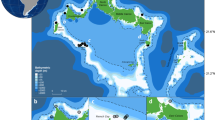Abstract
Estuarine migration of anosmic and control silver-phase American eels was examined during the fall spawning migration. Ultrasonic telemetry was used to track seventeen control and eight anosmic silver eels through 32 km of the Penobscot Estuary, Maine, U.S.A.. Twelve of seventeen control eels migrated out of the estuary in 97 h (approximately 4 d) on average. Only two of eight anosmic eels migrated out of the estuary. On average these two anosmic eels migrated out of the estuary within 180 h (approximately 7.5 d) of release and the other six had not left within 9 d. Most control eels progressed rapidly to the mouth of the estuary within a few days. Anosmic eels spent more time in the estuary and demonstrated different behavior from control eels due to their lack of olfaction. Some control eels moved with the appropriate tide, the ebb tide for transport out of the estuary, within one tidal cycle of being released into tidal freshwater. However, anosmic eels either did not move with the appropriate tide or took significantly longer to do so. Olfaction was probably used for orientation by control eels sensing chemical clues (organic and inorganic), which change throughout the tidal cycle. Increased migration times and errors in orientation were likely related to the inability of anosmic eels to use selective tidal stream transport for movement out of the estuary. Chemical clues seem to be one of the most important environmental clues used to guide estuarine migration of silver eels. However, a hierarchy of sensory mechanisms and environmental clues are most likely used for estuarine orientation.
Similar content being viewed by others
References cited
Barbin, G.P. 1996. The role of olfaction in migrations of the American eel (Anguilla rostrata): behavior and physiology. Ph.D. Dissertation, University of Maine, Orono. 206 pp.
Barbin, G.P. 1998. The role of olfaction in homing and estuarine migratory behavior of yellow-phase American eels. Can. J. Fish. Aquat. Sci. (in press).
Blaxter, J.H.S. 1988. Sensory performance, behavior, and ecology of fish. pp. 203–232. In: J. Atema, R.R. Fay, A.N. Popper & W.N. Tavolga (ed.) Sensory Biology of Aquatic Animals, Springer-Verlag, New York.
Facey, D.E. & G.S. Helfman. 1985. Reproductive migrations of American eels in Georgia. Proceedings of the Annual Conference, Southeast. Assoc. of Fish Game Comm. 39: 132–138.
Gray, R.W. & C.W. Andrews. 1971. Age and growth of the American eel (Anguilla rostrata LeSueur) in Newfoundland waters. Can. J. Zool. 49: 121–128.
Hain, J.H.W. 1975. The behaviour of migratory eels, Anguilla rostrata, in response to current, salinity and lunar period. Helgoländ. wiss. Meeresunters. 27: 211–233.
Haro, A.J. 1991. Thermal preferenda and behavior of Atlantic eels (genus Anguilla) in relation to their spawning migration. Env. Biol. Fish. 31: 171–184.
Hurley, D.A. 1972. The American eel (Anguilla rostrata) in eastern Lake Ontario. J. Fish. Res. Board Can. 29: 535–543.
Keefe, M. 1992. Chemically mediated avoidance behavior in wild brook trout, Salvelinus fontinalis: the response to familiar and unfamiliar predaceous fishes and the influence of fish diet. Can. J. Zool. 70: 288–292.
McCleave, J.D. & G.S. Wippelhauser. 1987. Behavioral aspects of selective tidal stream transport in juvenile American eels (Anguilla rostrata). Amer. Fish. Soc. Symp. 1: 138–150.
Oliveira, K. 1994. Age, size, sex, growth, and migrations of yellow and silver phase American eels. Ph.D. Dissertation, University of Rhode Island, Kingston. 126 pp.
Parker, S. J. 1995. Homing ability and home range of yellow-phase American eels in a tidally dominated estuary. J. Mar. Biol. Assoc. U.K. 75: 127–140.
Parker, S.J. & J.D. McCleave. 1997. Selective tidal stream transport by American eels during homing movements and estuarine migration. J. Mar. Biol. Assoc. U.K. 77: 871–889.
Rehnberg, B.G., B. Jonasson & C.B. Schreck. 1985. Olfactory sensitivity during parr and smolt developmental stages of coho Salmon. Trans. Amer. Fish. Soc. 114: 732–736.
Stasko, A.B. & S.A. Rommel. 1977. Ultrasonic tracking of Atlantic salmon and eels. Rapp, P-V Reun. Cons. Int. Explor. Mer. 170: 36–40.
Tesch, F.-W. 1979. Speed and direction of silver and yellow eels, Anguilla anguilla, released and tracked in the open North Sea. Ber. Deut. wiss. Komm. Meer. 23: 181–197.
Tesch, F.-W. 1994. Verfolgung von Blankaalen in Weser und Elbe. Fischökologie 7: 47–59.
Tesch, F.-W., H. Westerberg & L. Karlsson. 1991. Tracking studies on migrating silver eels in the Central Baltic. Meeresforschung 33: 183–196.
Vøllestad, L. A. 1992. Geographic variation in age and length at metamorphosis of maturing European eel: environmental effects and phenotypic plasticity. J. Anim. Ecol. 61: 41–48.
Vøllestad, L. A., B. Jonsson, N.A. Hvidsten, T.F. Næsje, Ø. Haraldstad & J. Ruud-Hansen. 1986. Environmental factors regulating the seaward migration of European silver eels (Anguilla anguilla). Can. J. Fish. Aquat. Sci. 43: 1909–1916.
Vøllestad, L. A., B. Jonsson, N.A. Hvidsten & T.F. Næsje. 1994. Experimental test of environmental factors influencing the seaward migration of European silver eels. J. Fish Biol. 45: 641–651.
Westin, L. 1990. Orientation mechanisms in migrating European silver eel (Anguilla anguilla): temperature and olfaction. Mar. Biol. 106: 175–179.
Author information
Authors and Affiliations
Corresponding author
Rights and permissions
About this article
Cite this article
Barbin, G.P., Parker, S.J. & McCleave, J.D. Olfactory clues play a critical role in the estuarine migration of silver-phase American eels. Environmental Biology of Fishes 53, 283–291 (1998). https://doi.org/10.1023/A:1007469232698
Issue Date:
DOI: https://doi.org/10.1023/A:1007469232698




